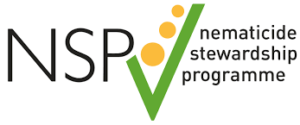Over the last 20-30 years, there’s been significant progress in our understanding of the biology and management of potato cyst nematode (PCN), yet it’s still regarded as one of the main threats to potatoes.
In this blog, we look at the new innovations that are helping potato farmers control PCN.
What is PCN?
PCN are microscopic parasitic roundworms that attack the roots of potato plants.
The nematodes lay eggs in protective cysts, which are the hardened bodies of dead female nematodes, making them particularly difficult to eradicate.
These cysts can remain dormant in the soil for several years, waiting for the presence of a suitable host plant to stimulate egg hatching.
The damage caused by PCN is twofold. Firstly, the nematodes feeding on the roots can directly reduce plant vigour and yield.
Secondly, the damage to the roots can make plants more susceptible to other diseases, increasing the impact on crop health and productivity.
There are two species of nematode that are of concern in the UK: G. pallida and G. rostochiensis. G. pallida is particularly concerning due to its resistance to control measures and its ability to cause significant yield reductions.
How widespread is PCN?
The prevalence of PCN is concerning, especially in previously untouched seed land in Scotland.
The James Hutton Institute has warned that at the current rate of spread, there could be in the region of five potato seed crops left that are not impacted by the pest.
Globodera pallida, has become the most prevalent of the two species infecting potato crops in the UK with the latest research showing occurrence at 95% of sites that have PCN present (Dybal, 2018).
The dominance of G. pallida has been caused by growing varieties with the H1 gene; a major gene that has resistance to G. rostochiensis.
For example, Maris Piper has the H1 gene and continues to be the most widely grown variety of potato in the UK.
How PCN tolerant varieties can help with control
Compared to 25 years ago there are many more resistant varieties available, such as Elland, Innovator, and Lanorma. These varieties are mainly used for processing and few options exist for fresh prepack markets.
However, while varietal resistance offers a solution to lowering PCN populations they don’t protect the tuber yield of infected plants. This is where PCN tolerance is important.
Varieties with PCN tolerance have extensive root systems that compensate for PCN root parasitism, meaning they can still produce acceptable yields.
Essentially tolerance needs to be used alongside resistance to avoid unwanted PCN multiplication.
Research into PCN resistant and tolerant varieties
The Potato Partnership has been investigating IPM control of PCN through resistant and tolerant varieties.
The Potato Partnership is an industry collaboration initiated by Agrii and founded on the model provided by the former AHDB Potatoes Spot Farms. Other partners include plant breeders, growers, manufacturers, and a wide range of agronomists.
Within the Potato Partnership there is a recognition that the industry urgently needs practical solutions to the pest and disease challenges facing the sector. To help alleviate this the group has been carrying out trials to evaluate the resistance and tolerance of a range of potato varieties.
2023 trial stats
- Location: a sandy loam site at Sutton, Suffolk.
- Method: The field was sampled and tested for PCN on a one-hectare grid basis, with the trial finally located within a 1 ha block with a population average of 9.56 eggs/g soil
2023 PCN trial results
The trial found that certain varieties were better at coping with the PCN burden. These included:
- Buster – (main crop) – this gave the lowest mean rate of multiplication of PCN
- Lanorma – (white maincrop)
- Cinderella – (early maincrop) – resistant to both PCN species.
- Iodea – (salad/ baby type) – resistant to both PCN species
- Lady Luce – resistant to both PCN species
- Bruar – resistant to both PCN species
Varieties that increased the level of PCN included:
- Markies (not resistant) – this variety caused the PCN numbers to increase the most
- Maris Peer (not resistant)
- Sensation (partially resistant)
- Decibel (partially resistant)
The results suggest that breeders are introducing a range of varieties with good levels of both tolerance and resistance to G. pallida.
This offers the prospect, subject to market acceptability, of helping in a strategic approach to managing PCN.
How granular nematicides help control PCN
Granular nematicides, applied to the seedbed, help protect the yield of potatoes by preventing infective PCN juveniles from reaching the roots, limiting penetration and feeding damage.
Granular options have dwindled in the past 5 years with Mocap 15G® (a.s. ethoprophos) and Vydate 10G® (a.s. oxamyl) being withdrawn in 2019 and 2020, respectively.
Current granular options include Nemathorin® 10G (a.s. fosthiazate), which is widely regarded as the most effective nematicide and is currently registered until July 2029.
If you are using Nemathorin this season you must follow the NSP Protocol to support the product’s future.
Granular nematicides are an essential tool in any integrated management strategy to reduce yield losses, and it is safe and responsible use which will help retain them for the future.
The NSP best practice steps bring together practical advice on how to use granular nematicides safely and forms part of the Red Tractor Standard for growers.
To find more information on the NSP protocol click here.
And, to watch the video click here.
Biofumigants for PCN control
PCN populations can be lowered by the inclusion of biofumigant brassica cover crops.
Performed correctly, these measures have the potential to reduce populations to manageable levels and shorten rotations.
Brassica biofumigants, such as Indian mustard, are grown during the summer months, typically behind crops such as winter barley, vining peas or carrots.
Their activity on PCN comes from volatile and toxic compounds, mainly isothiocyanates, produced from chopped stems and leaves of plants that have reached early flowering.
There is extensive work on biofumigation, and researchers around the world have recorded suppression against a range of pests, weeds and diseases.
A number of UK studies have focused on biofumigant activity against PCN and have shown reductions of the pest typically ranging from 35-70%.
How to get the most out of biofumigants for PCN control
The aim is to grow maximum biomass and to accomplish this you must:
- Achieving optimal sowing (date and method)
- Apply adequate supply of nitrogen – typically 80-100 kg N ha
- Apply sulphur – 25 kg S/ha
- Correct date of chopping – aim for green bud to early flowering
- Chop using a rotary flail and incorporate via a rotavator or spader to achieve better results
- Soil moisture needs to be at 60-80% of field capacity
- Do not use on acidic soils with a pH lower than 5.5 as this influences the effectiveness of the process
How trap crops can control PCN
Solanaceous trap crops offer another tool for lowering PCN populations in potato rotations.
Prickly nightshade (Solanum sisymbriifolium) is the most well-known trap crop and was used more commonly in the mid-2000s.
Trap crops, typically native to South America, are close relatives to potatoes, which stimulate PCN hatch by producing chemicals that trick the pest into hatching.
Infective PCN juveniles can penetrate the roots of these plants but not fully complete their lifecycles, due to the plants’ defence responses.
The trapping activity of these ‘dead end plants’ leads to reductions in PCN populations as high as 85%.
The challenge of growing trap crops is achieving consistent results with establishment and plant development.
How to get the most out of trap crops for PCN control
- Ensure seed is sown at a shallow depth of 0.5-1cm
- Make sure there’s sufficient moisture in the soil
- Enable seed-to-soil contact
- Standard or precision drilling could be more effective than broadcasting
In summary, there’s a good opportunity for trap crops and biofumigants to be used within integrated control programmes for the management of potato cyst nematodes.


